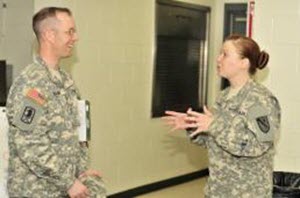Story by: Staff Sgt. Jennifer Atkinson
Posted: April 26, 2015
 Master Sgt. Daniel Griego
Master Sgt. Daniel Griego
Staff Sgt. Kelly Lee, Joint Task Force 136 (Maneuver Enhancement Brigade) chaplains' assistant, talks with 1st Lt. James McCann, 625th Network Support Company during annual training, April 19-25, 2015, at Camp Swift, near Bastrop, Texas. (U.S. Army National Guard photo by Master Sgt. Daniel Griego/Released)
AUSTIN, Texas - It's no secret that war is hell, but the Texas Guardsmen of Joint Task Force 136 (Maneuver Enhancement Brigade) can face frightening and disturbing situations during disasters at home, too. After long days and nights spent helping communities after hurricanes or other disasters, even the most resilient personalities benefit from the cheerful smile and caring presence of Staff Sgt. Kelly Lee.
Lee is a key member of the Unit Ministry Team, ready to step in to help take a load off worried minds. Emotional support is absolutely critical in homeland missions, said Lee, the brigade chaplain's assistant. “We're trained to see military personnel put in harm's way,” she said, “but the defense support to civil authorities mission is working with American citizens and we train hard for America's worst day.”
Working a disaster scene can be different from training, said Lee, due to the intimate relationship between Texas citizen-Soldiers and their communities.
“You can't train for Soldiers to have to deal with mom and dad, and grandma and grandpa and Fido,” she said, “and that can cause folks to break down.”
To help mitigate that stress, the brigade chaplain works a comprehensive religious support plan in to the overall standard operations guide. Ideally, that plan includes a chaplain and assistant who have worked together and know their Guardsmen, said Lee. Working and resting alongside those under their care makes sure the religious support teams, formerly called unit ministry teams, are positioned to be responsive and effective in times of need.
“Best case, we've got one cohesive UMT with the each part of the brigade,” said Lee, “including chaplains in the staging areas.”
Multiple chaplains also help take care of each other, in case one chaplain is injured or needs support as well.
“This is spiritual care at the tactical level,” said Lee.
Even as other brigade members have “go-bags” ready, the UMT makes sure they're ready at a moment's notice too. A “go-box” with Bibles, religious books, communion supplies and prayer tokens is part of the field packing list.
“They're gestures to show we care, because our entire job is those troops,” she said.
RST care isn't just pastoral or religious, though.
“Being there for someone doesn’t mean you have to be a pastor, or chaplain,” she said.
Going over the events of the day can help Guardsmen put events in perspective.
“What did you do, what did your buddy do? What did you do right? What did you do wrong? What did you hear, or see or smell? That's all important too,” she said.
Learning skills to help other Guardsmen cope is an important part of the training. Traumatic event management courses allow RST members to help both individuals and groups in the field. Those skills, the “ministry of presence” is at least as important as overtly religious support, allowing Lee to be “just there, listening and comforting.”
The biggest challenge for Lee is logistical.
“There are whole lot more of them than there are of us, but we do everything we can to make sure we're out here for them,” she said, but that challenge doesn't deter Lee or any of the RST members.
“When I see a smile on their face,” said Lee, “that's all the reward I need, and they don't even know they're giving it to me half the time. I just don't need anything else.”